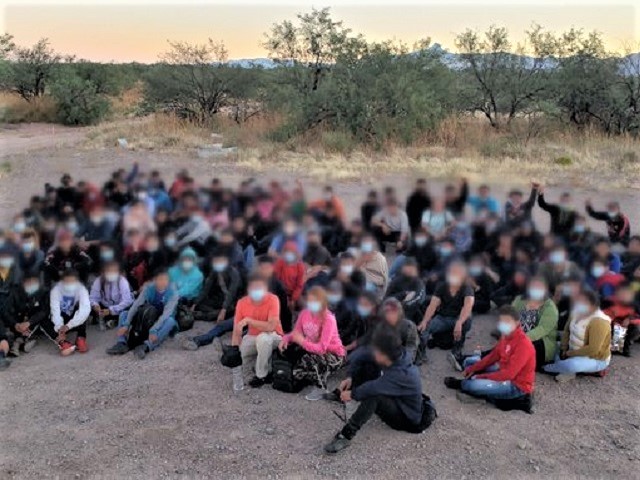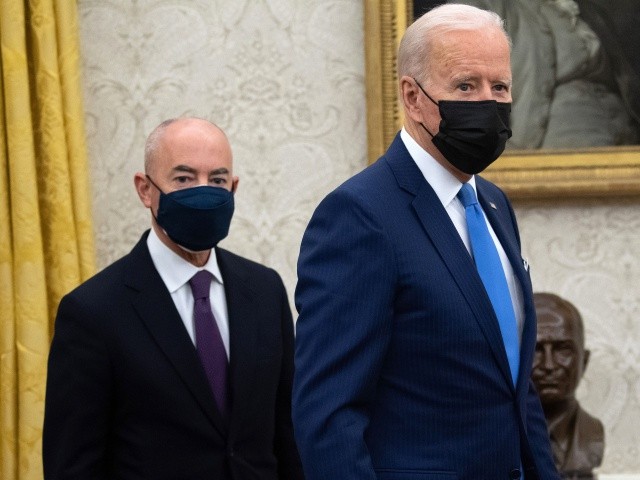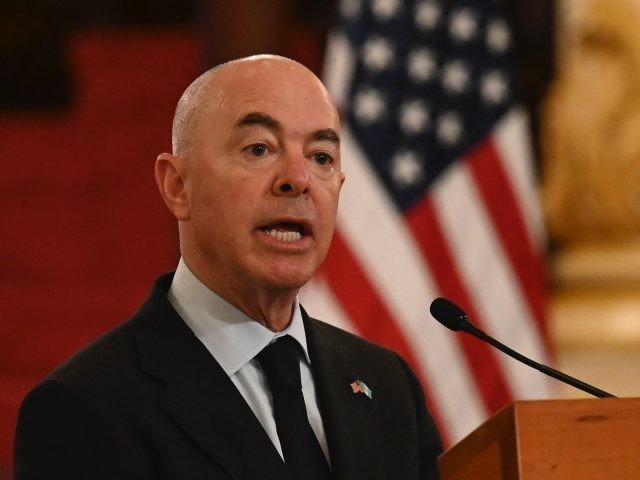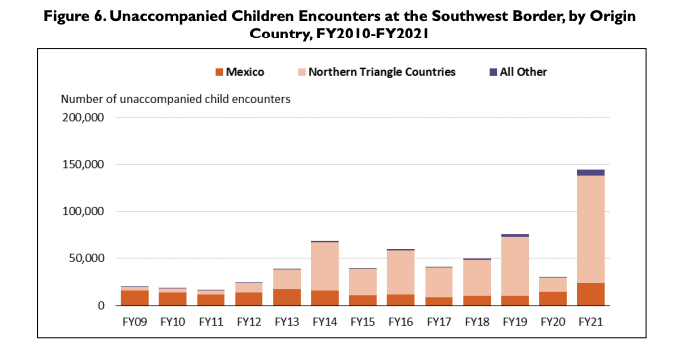President Joe Biden’s pro-migration border chief is offering work permits to the hundreds of thousands of young migrants who were smuggled into the United States via the “Unaccompanied Alien Children” (UAC) pipeline.
The new policy will provide “even more of a bonus for the smugglers and for the unscrupulous employers who look forward to being able to put these [UAC] minors to work in their poultry plants, restaurants, landscaping companies, and fields,” said Jessica Vaughan, the policy director at the Center for Immigration Studies. ‘They’re going to rubber-stamp [the work permit applications] as quickly as they can,” she added.
“I’m so happy [the government] is finally doing the right thing here and making it so young people with Special Immigrant Juvenile Status can support themselves and build a life,” tweeted Laura Barrera, an immigration lawyer working at the Ohio State University in Columbus, Ohio. “I don’t believe in deportation … in any case,” she tweeted on February 5.
The program is a stealthy spin-off of the highly controversial DACA giveaway — the “Deferred Action for Childhood Arrivals” created by President Barack Obama in 2012 for roughly 800,000 migrants. Under DACA, officials give no-deportation passes and work permits to people who say they are illegal aliens.
“They’re creating the next DACA-like population,” said Rob Law, who worked at the Department of Homeland Security for President Donald Trump. “This is about giving work permits to the illegal-alien population … it’s about establishing the class of next non-U.S. citizen workers in the country.”
The numbers are potentially huge. In 2009, just 3,533 young people from Honduras, Guatemala, and El Salvador claimed UAC status as they crossed the border. The number jumped to 21,000 in 2013, and then 52,000 in 2o14. The UACs numbers dropped to 15,687 in 2020 under President Donald Trump’s cautious policies but spiked to 114,0211 under Mayorkas’s easy-migration rules.
Overall, almost 600,000 UAC migrants had entered the country by January 2022, just 14 years after Congress unanimously passed the UAC law in 2008.
Biden’s border chief is Alejandro Mayorkas at the Department of Homeland Security (DHS). Mayorkas is portraying the giveaway as a benevolent gift to abandoned young migrants, dubbed “Special Immigrant Juveniles,” or SIJs.
“Today, we are taking action to help immigrant children in the U.S. who have been abused, neglected, or abandoned and offer them protection to help rebuild their lives,” said a statement from Ur Jaddou, at Mayorkas’s U.S. Citizenship and Immigration Services (USCIS) agency. “These policies will provide humanitarian protection to vulnerable young people for whom a juvenile court has determined that it is in their best interest to remain in the United States,” said Jaddou.
Mayorkas is a wealthy and clever lawyer. His memo dismisses the impact of job competition on Americans’ wages: “Exercising our discretion to grant deferred action and possibly authorizing employment provides significant benefits to the U.S. labor pool and the economy in general compared to delaying such status.” For decades, that labor market has been tilted in favor of CEOs and investors by the federal government’s policy of extracting migrants from many poor countries to work, rent, and consume in the United States.
Under the 2008 UAC law, young migrants can ask border officials to treat them as unaccompanied alien children — even when coyotes and cartels publicly deliver them to the border in chartered buses that are funded by the migrants’ parents or by labor traffickers. Border officers then relay the blocs of supposedly unaccompanied migrants to the Department of Health and Human Services. The agency then relays the migrants to unverified sponsors after a security check, which is kept cursory because officials know the sponsors are usually labor traffickers or the youths’ illegal-immigrant parents.
“Honestly, I think almost everyone in the system knows that most of the [migrant] teens are coming to work and send money back home,” Maria Woltjen, executive director and founder of the Young Center for Immigrant Children’s Rights, told a ProPublica reporter. “They want to help their parents,” she said in a November 2020 article which cited the case of Garcia, a Guatemalan youth who used the UAC loophole in 2018:
He was 15 and he had debts to pay, starting with the roughly $3,000 he owed for the “coyote” who guided him across Mexico from Guatemala. To finance the trip, his parents had taken out a bank loan, using their house as collateral. If he didn’t repay it, the family could lose its home.
The “everyone in the system knows” category includes many federal legislators and Mayorkas. He told Univision anchor Jorge Ramos in a March 2021 interview that “we need to invest and address the root causes so that parents do not need to send their children … to be placed in the hands of traffickers.”
At least 60 percent of the UACs are work-ready male youths, aged 16 or older the year they arrive. Many walk away from federal supervision to illegally take jobs that would otherwise go to diverse Americans at higher wages.

Of 125 migrants apprehended near San Miguel, Arizona, on October 10, 3/4ths were unaccompanied children. (Photo: U.S. Border Patrol/Tucson Sector)
The younger UACs are the left-behind children of illegal migrants in the United States. The joint DHS-coyote smuggling route encourages migrants to separate themselves from their families by first going alone to the United States. The Mayorkas/coyote network also minimizes pressure on illegal migrants to go home, boosting New York City and other cities that prefer to build an economy on cheap labor.
The SIJ program was created in 1990 “to give [legal] status to kids who are on their own, truly left on their own, with no one else to turn to here in the United States — [such as] victims of trafficking or abandoned kids or orphans,” Vaughan said. “But the [implementing] rules were written with loopholes that you can drive a truck through,” she added.
The SIJ program is now being used by Mayorkas to help legalize the migrants who got into the country via the UAC program.
The UAC program was passed unanimously by Congress in 2008. It was also portrayed as a small-scale, short-term rescue program for the children who were victims of sex trafficking, for example.
Progressives are eager to ignore their support for the trafficking of child labor via the UAC pipeline. In February, Reuters reported on a teenager who was delivered by federal officials to an Alabama home close to a chicken processing company:
At age 16, when most kids in the United States are halfway through high school, Amelia Domingo found herself working on chicken processing machines in this farm town [Enterprise, Ala.] and deep in debt to loan sharks in her native Guatemala.
After borrowing $10,000 for smugglers to get her through Mexico, Amelia crossed into Arizona last February and turned herself over to [Customs and Border Protection] immigration officials. They led her, she said, from a crowded border facility to a shelter for unaccompanied minors. After about a month, officials from the U.S. Department of Health and Human Services, which oversees shelters for migrant children, released her to a sister here in Alabama.
…
One day, she said, she hopes to return to Guatemala. First, though, she must continue wiring most of her wages home, where her parents pay off the loan sharks and what she said is a dizzying interest rate of 10% per month. She’ll return, she said, “if I ever have the means.”
But the UAC law cuts off when DHS officials can no longer pretend that the young men and women are children. Three years after a young man tells border officials that is really aged 15, he is recorded as being an 18-year-old adult in the federal documents.
That is where Mayorkas’s new SIJ rule is intended to take over from the UAC law.
The SIJ law allows young migrant adults to ask judges for SIJ status — and green cards and citizenship — on the grounds that they were abandoned by the parents who funded their trip to the United States, and who usually stay in close contact via cellphones. They can ask for green cards even if one of their illegal-migrant parents is standing in the courtroom, said Vaughan.
The parents accused of abuse cannot defend themselves in court. But they do not want to defend themselves because they prefer the state judges — not federal judges — to award green cards to their children, she added.
But the SIJ pathway to green cards is already clogged.
Tens of thousands of former UACs are getting new SIJ status so they can apply for green cards. Yet the number of green cards awarded each year to the SIJs is limited because they come from the roughly 10,000 green cards allocated for various competing categories of “EB-4” migrants.
The number of claimed SIJs who were approved to get green cards spiked from 1,590 in 2012 up to 15,101 in 2016.
Mayorkas’s support for migrants includes two measures.
First, Mayorkas’s plan would reward the young migrants by giving them work permits before they eventually get their green cards.
A “Policy Alert” on March 7 says the agency will offer “deferred action (and related employment authorization) for noncitizens [aliens] classified as Special Immigrant Juveniles (SIJs) who are ineligible to apply for adjustment of status to lawful permanent resident (LPR) status solely due to visa unavailability.”

President Joe Biden stands alongside Secretary of Homeland Security Alejandro Mayorkas after signing executive orders related to immigration in the Oval Office of the White House in Washington, DC, February 2, 2021. (Photo by SAUL LOEB/AFP via Getty Images)
This decision to award workers deferred action and permits to tens of thousands of migrants is a mere memo, not a congressional law or agency regulation:
This update, contained in Volume 6 of the Policy Manual, is effective May 6, 2022 and applies to eligible noncitizens classified as SIJs before, on, or after that date based on an approved Petition for Amerasian, Widow(er), or Special Immigrant (Form I-360). This guidance is controlling and supersedes any prior guidance on the topic.
…
USCIS will not publish Federal Register notices requesting public comment because public notice is not required for internal policy clarifications.
The second measure is a draft regulation that streamlines the process of getting SIJ status for the migrants. For example, it says that the migrants can apply up to age 21, it allows judges in juvenile courts to grant the SIJ status, and that DHS will not “revoke” the SIJ status when the young migrant reconciles with a parent.
It says the SIJ request must be approved in 180 days, and also removes legal barriers, such as convictions for drug possession:
In the final rule, DHS has expanded application of the simple possession exception to the grounds of inadmissibility under INA section 212(a)(2)(A), 8 U.S.C. 1182(a)(2)(A) (conviction of certain crimes), INA section 212(a)(2)(B), 8 U.S.C. 1182(a)(2)(B) (multiple criminal convictions), and INA section 212(a)(2)(C), 8 U.S.C. 1182(a)(2)(C) (controlled substance traffickers). See new 8 CFR 245.1(e)(3)(v)(A).
The combination of the “Policy Alert” and the draft regulation is “huge,” tweeted Yliana Johansen-Méndez, an immigration lawyer at ImmDef, an L.A.-based advocacy group. “Although they don’t address the backlog itself, they provide stability & a chance to live life as members of our community – without fear of deportation, working, and in some cases starting a family.”
The new rules will encourage more labor migration into Americans’ jobs, responded Law. “You’re going to have an increased volume … USCIS is [becoming] a work-permit factory for illegal aliens instead of actually adjudicating legal immigration benefits,” he said.
Since at least 1990, the D.C. establishment has used a wide variety of excuses and explanations to justify its policy of extracting tens of millions of migrants and visa workers from poor countries to serve as workers, consumers, and renters for U.S investors and CEOs.
The economic strategy of extraction migration has no stopping point, and it is harmful to ordinary Americans because it cuts their career opportunities and their wages while also raising their housing costs.
Extraction migration also curbs Americans’ productivity, shrinks their political clout, and widens the regional wealth gaps between the Democrats’ coastal states and the Republicans’ Heartland states. The economic strategy also kills many migrants, violates workplace standards, separates families, and extracts wealth from the home countries.
An economy built on extraction migration also radicalizes Americans’ democratic, compromise-promoting civic culture and allows wealthy elites to ignore despairing Americans at the bottom of society. Migration is also backed by university progressives who desire to manage the chaos of a diverse society rather than being forever sidelined by cooperating citizens in a stable Republic.
Unsurprisingly, the wealth-shifting extraction migration policy is very unpopular, according to a wide variety of polls.
The polls show deep and broad public opposition to labor migration and the inflow of temporary contract workers into jobs sought by young U.S. graduates.
The opposition is growing, anti-establishment, multiracial, cross-sex, non-racist, class-based, bipartisan, rational, persistent, and recognizes the solidarity that Americans owe to one another.


COMMENTS
Please let us know if you're having issues with commenting.